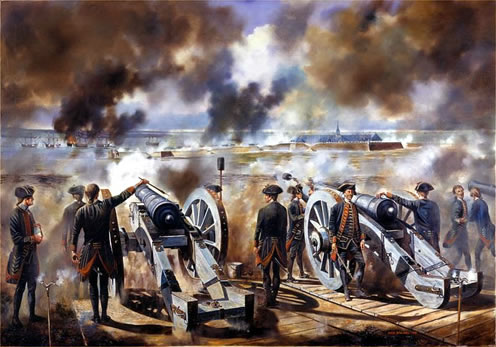
"Captain C Brome's Company of the Royal Artillery at the Siege of Louisburg"
Ref: DR007
by David Rowlands
Image Size: 58 x 38 cm
July 1758: Louisburg stands on the coast of Cape Breton Island, Canada. It was a very strong French fortress with batteries defending an extensive harbour. On the landward side was a curtain wall with four bastions projecting from it. The British expedition to capture it sailed from Halifax, Nova Scotia. After fighting their way ashore, the British disembarked their heavy siege guns, ammunition and equipment, despite a heavy surf. Much effort and strenuous labour were needed to get these ashore, and then a road, founded on brushwood fascines, had to be laid by 500 men to cross the marshy ground to reach the position chosen for the siege batteries.
The British batteries were no more than 500 yards from the enemy's guns on the walls, so heavily protected gun positions had to be erected, with thousands of sandbags, and timber to form the embrasures. Heavy guns could recoil eight feet when they were fired, so they had to be placed upon heavy timber platforms to prevent them sinking into the ground. When the British siege guns eventually opened fire in the second half of July, they proved devastating to the walls of the fortress. British mortars started fires in the town, and three of the French ships of the line in the harbour were set on fire and destroyed. Only three French guns remained in action at the Western side of the fortress when the Governor surrendered the fortress.
The painting depicts iron 24-pounder siege guns on their platforms. At the left the firer puts his portfire to the vent to ignite the charge. Gunners had to stand at a safe distance to each side of the gun, which will violently recoil backwards. A gunner waits to hand a new cartridge to the loader, who stands at the front of the gun. Behind each gun a linstock placed in the ground bears a lighted slow match, from which the portfire was ignited.
At the right of the picture the spongeman rams home the charge of gunpowder, while the loader waits to insert a roundshot into the muzzle. The ventsman places his thumb over the vent to prevent the rush of air from the newly rammed charge rekindling any spark that might still be in the bore. The firer waits for these tasks to be done.
This Company of the Royal Artillery served in Canada from 1746 to 1766. Captain C Brome commanded it from 1751 to 1758, when Captain T Ord took command at Louisburg.
